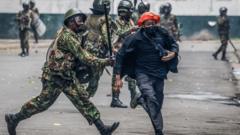As the Sinaloa Cartel grapples with internal betrayal and government crackdowns, its future remains uncertain, potentially leading to the downfall of one of the world's most powerful criminal organizations.
Internal Strife Threatens the Stability of the Sinaloa Cartel

Internal Strife Threatens the Stability of the Sinaloa Cartel
The Sinaloa Cartel, a dominant player in global drug trafficking, faces an escalating internal conflict and increased governmental pressure.
In a chilling revelation, the Sinaloa Cartel, known as one of the drug world's most notorious syndicates, is in the throes of an intense internal war, exacerbated by a dual crackdown from the U.S. and Mexican authorities. Amidst this turmoil, analysts suggest this could be the beginning of the end for the cartel as we know it.
The Sinaloa Cartel is infamous for its role in the mass production and distribution of fentanyl, a powerful opioid that has significantly impacted the American landscape, resulting in a staggering rise in drug-related fatalities. However, recent developments indicate a seismic shift within its ranks. The betrayal of a high-ranking leader’s partner has unleashed a wave of violence and distrust, as factions vie for power and resources in a desperate fight for survival.
The cartel is now facing difficulties it has never encountered before. With extensive financial strains and a loss of key members, its operations are becoming increasingly compromised. Law enforcement agencies in both the U.S. and Mexico are capitalizing on this vulnerability, intensifying their efforts to dismantle the network.
The rise of rival factions and the ongoing internal strife suggest that the once-unshakeable grip of the Sinaloa Cartel might be loosening. Questions linger: Can the cartel withstand this pressure, or will it succumb to the crushing weight of its enemies, both external and internal?
As the conflict unfolds, the implications are significant not just for those involved in the cartel but also for communities impacted by its operations. The Sinaloa Cartel has long been a critical player in the international drug trade, and its potential decline could reshape dynamics in drug trafficking and law enforcement efforts on both sides of the border.
The Sinaloa Cartel is infamous for its role in the mass production and distribution of fentanyl, a powerful opioid that has significantly impacted the American landscape, resulting in a staggering rise in drug-related fatalities. However, recent developments indicate a seismic shift within its ranks. The betrayal of a high-ranking leader’s partner has unleashed a wave of violence and distrust, as factions vie for power and resources in a desperate fight for survival.
The cartel is now facing difficulties it has never encountered before. With extensive financial strains and a loss of key members, its operations are becoming increasingly compromised. Law enforcement agencies in both the U.S. and Mexico are capitalizing on this vulnerability, intensifying their efforts to dismantle the network.
The rise of rival factions and the ongoing internal strife suggest that the once-unshakeable grip of the Sinaloa Cartel might be loosening. Questions linger: Can the cartel withstand this pressure, or will it succumb to the crushing weight of its enemies, both external and internal?
As the conflict unfolds, the implications are significant not just for those involved in the cartel but also for communities impacted by its operations. The Sinaloa Cartel has long been a critical player in the international drug trade, and its potential decline could reshape dynamics in drug trafficking and law enforcement efforts on both sides of the border.





















